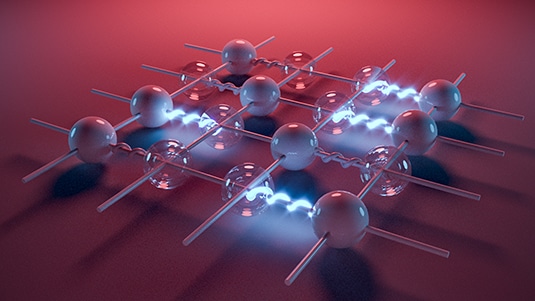Sep 19 2019
An international team of physicists has used ultracold atoms in optical lattices to successfully engineer main ingredients needed to successfully simulate a particular lattice gauge theory.
 Christoph Hohmann. (Image credit: LMU München/MCQST)
Christoph Hohmann. (Image credit: LMU München/MCQST)
Gauge bosons mediate the fundamental interactions between particles. In general, these are characterized by gauge theories, which are very difficult to theoretically treat in a broad array of parameters. It is an extremely challenging task to deal with some of these open questions in table-top experiments with uniquely designed quantum simulators.
At present, researchers from LMU and the Max Planck Institute of Quantum Optics partnered with collaborators from the Technical University Munich, Harvard University, and the Université Libre de Bruxelles to successfully simulate the key ingredients of a particular lattice gauge theory using two-component ultracold bosons in optical superlattices.
The research has been reported in the scientific magazine Nature Physics and was highlighted with a News and Views article.
How Do Elementary Constituents of Matter Interact with Each Other?
In modern physical sciences, one of the difficult challenges is to identify elementary constituents of matter, as well as the way in which these particles interact with each other. This basic problem arises in several areas of physics, such as high-energy, condensed matter and quantum computation.
Despite the outstanding success in confirming the occurrence of abundant elementary particles and novel unusual phases of matter, several fundamental questions are still unanswered owing to the great complexity of the challenge. In this regard, one of the most famous examples is the hitherto deficient understanding of the phase diagram of Quantum Chromodynamics, which illustrates the strong interaction between gluons and quarks.
New Insights by Quantum Simulation
With the huge advancement in the ability to control individual particles, such as atoms, ions, and photons, it has been proposed that quantum simulations could provide novel understanding about the open questions with respect to the fundamental interactions between (quasi-)particles, mediated by gauge fields. At first, the quantum simulation concept was put forward by Richard Feynman, a Nobel prize winner.
The main concept is to develop a quantum many-body system customized to emulate the properties of a specified theoretical model, thereby providing a clear picture of the fundamental physical phenomena of interest in a controlled laboratory environment. Quantum systems engineered using ultracold atoms in optical lattices turned out to be versatile platforms to analyze the properties of exotic quantum phases of matter.
However, it is very challenging to simulate gauge fields as it necessitates the accurate implementation of matter particles and gauge fields, which interact such that the local symmetry of the gauge theory of interest is not affected.
Simulating Gauge-Mediated Interactions with Charge-Neutral Atoms
A group of physicists from LMU Munich and the Max Planck Institute of Quantum Optics (MPQ), headed by Professor Monika Aidelsburger and Professor Immanuel Bloch, took utmost care to design and successfully achieved the basic ingredients of a particular minimal lattice gauge theory—a Z2 lattice gauge theory—that has a vital role to play in quantum computation and condensed matter physics.
The team achieved a controllable quantum simulator of ultracold bosonic particles entrapped in a bichromatic optical lattice. By isolating the dynamics of two particles in a double well, they achieved controlled analysis of the fundamental building block of the theory, which could be used in future experiments to develop extended models.
Laser beams were used for manipulating the complex interactions between the particles. The intensity of the beams was modulated periodically in time. The difficulty faced was to implement well-determined local interactions between “matter” particles and “gauge bosons,” which are the mediators of fundamental interactions.
Two distinct electronic states of the atoms were used by the experimentalists to emulate the different types of particles. In addition, the local interactions have been achieved by dealing with the atoms in a state-dependent way. The researchers validated an innovative strategy based on periodic driving by noticing the dynamics of the atoms site- and state-resolved.
The outstanding insights into the microscopic parameters of the model further enabled them to sketch the path for further experiments in higher dimensions and extended geometries.
While it is still a long path to advance existing experimental platforms in a way that will enable us to shed new light onto fundamental open questions regarding the phase diagram of Quantum Chromodynamics, these are exciting times for quantum simulators, which develop at a remarkable rate.
Christian Schweizer, Study Lead Author, LMU
The researchers have taken the initial steps in the long path toward analyzing high-energy physics problems using table-top experiments. This research offers an innovative path for solving the extreme difficulties faced by experimentalists in simulating the fundamental interactions between elementary constituents of nature using currently available protocols.